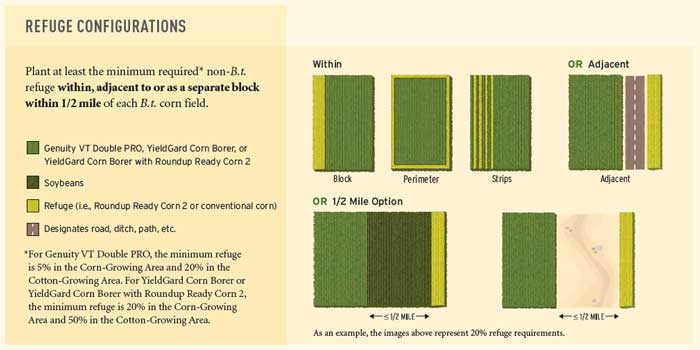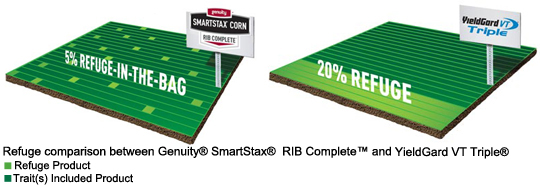Learn More about Refuge Requirements
What is refuge and what is its purpose?
Farmers who plant crops with Bt trait(s) must also plant a refuge area -- a block or strip of crops without the Bt gene. The purpose of the refuge area is to prevent pests from developing resistance to the technology.
By leaving non-Bt crops in the field, insects who feed on that crop remain susceptible to Bt technology. When they then mate with the rare insects that survive after feeding on Bt corn, they produce offspring that is susceptible to the technology. This works to preserve the effectiveness of Bt technology, which helps the corn plants protect themselves from the pests that feed on their roots, damage them, and ultimately reduce yield for farmers.
The image below shows some examples of refuge configurations farmers can use with Genuity® VT Double PROTM corn. Refuge recommendations and configurations can be found in our Insect Resistance Management (IRM) guide.


Why do some products have lower refuge requirements than others?
The U.S. Environmental Protection Agency (EPA) requires a corn field that contains insect-protected (or Bt) crops with a single mode-of-action against corn rootworm to be planted with 20% non-Bt corn in corn-growing areas (the U.S. Corn Belt) and 50% non-Bt in cotton-growing areas (the U.S. Cotton Belt).
New seed technologies that have multiple Bt genes, or modes-of-action, such as Genuity® VT Double PROTM and Genuity®SmartStax® provide additional protection and effectively reduce the likelihood of insect resistance developing.* This enabled the EPA to reduce the size of structured refuge from 20% to 5% in corn-growing areas, and from 50% to 20% in cotton-growing areas. Additionally, farmers in the Cotton Belt can reduce their refuge acres with Genuity® VT Triple PROTM com from 50% to 20%.
And with Genuity® RIB CompleteTM products, refuge management is even easier for farmers because the right amount of refuge seed is included in the bag. Farmers simply put the RIB Complete seed in the planter and plant both the corn crop and the refuge in a single trip down the field. No more separate, structured refuge. No more dealing with multiple bags and products. No more calculating. With these products, the refuge compliance is off farmers' shoulders and in our hands.


How does a farmer benefit from a reduced refuge?
Farmers benefit in:
- cost savings
- planting simplification
- increased yield
For example, a 5% percent refuge for Genuity SmartStax RIB Complete means farmers will be able to plant 15% more of their acres with biotech traits, raising on-farm yields. Additionally, reduced refuge allows farmers to reduce insecticide use, as more of their crop has in-plant protection.









